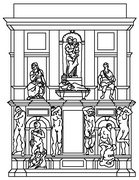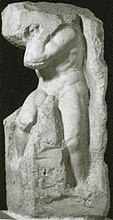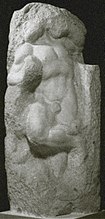Tomb of Pope Julius II
You can help expand this article with text translated from the corresponding article in Italian. (January 2021) Click [show] for important translation instructions.
|
| Tomb of St. Matthew (Michelangelo) | |
|---|---|
| Followed by | Moses (Michelangelo) |
The Tomb of

As originally conceived, the tomb would have been a colossal structure that would have given Michelangelo the room he needed for his superhuman, tragic beings. This project became one of the great disappointments of Michelangelo's life when the pope, for unexplained reasons, interrupted the commission, possibly because funds had to be diverted for
The most famous sculpture associated with the tomb is the figure of Moses, which Michelangelo completed during one of the sporadic resumptions of the work in 1513.[citation needed] Michelangelo felt that this was his most lifelike creation. Legend has it that upon its completion he struck the right knee commanding, "now speak!" as he felt that life was the only thing left inside the marble. There is a scar on the knee thought to be the mark of Michelangelo's hammer.
History
- 1505 – Julius commissions a tomb from Michelangelo, who spends eight months choosing marble at Carrara.[5] Sometime during construction, however, Michelangelo and the Pope have a quarrel, causing Michelangelo to leave Rome for his safety.[6]
- 1508[Vatican Palace. He, along with Michelangelo's other rivals, thought that Michelangelo would be unable to complete the massive ceiling project and thus be humiliated and leave Rome.[7]
- 1512 – With his decoration of the Sistine Chapel ceiling complete, Michelangelo resumed work on the tomb. Between 1512 and 1513 he completed three sculptures for the project: the Dying and Rebellious Slaves (now in the Louvre, Paris) and Moses (retained in the final design). [citation needed]
- 1513 – Julius died in February 1513. A new contract was drawn up on 6 May which specified a wall tomb. On 9 July Michelangelo contracted a stonemason, Antonio del Ponte a Sieve, to execute the architectural elements of the tomb's lower register, which can be seen in the final design.Kupferstichkabinett in Berlin; a more legible facsimile by his pupil Jacomo Rocchetti is also in the same collection. The Metropolitan Museum of Art in New York City has a drawing of the tomb from this period.[9] Though no longer for a free-standing monument, the project in fact became more ambitious both in terms of size and the complexity of its iconography.[10]
- 1516 – Michelangelo agrees to a new contract with Julius's heirs, who demand the completion of the project.
- 1520s – Michelangelo carves Accademia, Florence).
- 1532 – Michelangelo signs a second new contract, which involves a wall-tomb.
- 1542 – Michelangelo begins the wall-tomb after negotiating final details with Julius's grandson.
- 1545 – The final tomb, more properly a funerary monument because Julius II is not interred there, is completed and installed in San Pietro in Vincoli; it includes Michelangelo's Moses along with Leah and Rachel (probably completed by Michelangelo's assistants) on the lower level, and several other sculptures (definitely not by Michelangelo) on the upper level.
-
Reconstruction of the original project of 1505 for a freestanding tomb (after Franco Russoli, 1952)[11]
-
Reconstruction of the 1513 project, based on a drawing by Jacomo Rocchetti (a pupil of Michelangelo) in the Kupferstichkabinett, Berlin
-
Reconstruction of the 1516 project
-
Reconstruction of the 1532 project
Sculptures
The statues of the Dying Slave and the Rebellious Slave were finished but not included in the monument in its last and reduced design.[12] They are now in the Louvre. Another figure intended for Pope Julius' tomb is The Genius of Victory, now in the Palazzo Vecchio in Florence. Other sculptures for the tomb were the Young Slave, the Atlas Slave, the Bearded Slave and the Awakening Slave. The sculptures of Rachel and Leah, allegories of the contemplative and the active life, were executed by Raffaello da Montelupo, a pupil of Michelangelo. The other sculptures are by less experienced pupils.
-
The Genius of Victory (1527–1530)[13]
See also
References
- ^ Marinazzo, Adriano (2018). "La Tomba di Giulio II e l'architettura dipinta della volta della Sistina". Art e Dossier. 357: 46–51.
- ^ Kleiner, Fred S., Christin J. Mamiya, and Helen Gardner. Gardner's Art Through the Ages. 12th ed. Belmont: Wadsworth, 2004.
- ^ Sweetser 1878, p. 92
- ^ Sweetser 1878, p. 107
- ^ Vasari, Giorgio (1850). Lives of the most eminent painters, sculptors, and architects: translated from the Italian of Giorgio Vasari. Vol. 5. London: Henry G. Bohn. p. 246.
- ^ Vasari 1850, pp. 250–252
- ^ Vasari 1850, p. 254
- ^ Panofsky 1937, p. 566
- ^ "Michelangelo Buonarroti: Project for a Wall Tomb for Pope Julius II (62.93.1)". In Heilbrunn Timeline of Art History. New York: The Metropolitan Museum of Art, 2000. (October 2006)
- ^ Panofsky 1937, p. 577
- ^ Panofsky 1937, pp. 561–579.
- The Slave in European Art,ed Elizabeth McGrath and Jean Michel Massing, London, The Warburg Institute, 2012
- ISBN 0140220224.
Sources
- JSTOR 3045700.
- Sweetser, Moses Foster (1878). Michael Angelo. Boston: Houghton, Osgood and Company.
Further reading
- Frommel, Christoph Luitpold, Maria Forcellino, Claudia Echinger-Maurach, Antonio Cassanelli, Roberto Jemolo, Forcellino, Antonio, Cassanelli, Roberto, and Jemolo, Andrea. Michelangelo's Tomb for Julius II : Genesis and Genius. Los Angeles: J. Paul Getty Museum, 2016.
- Tononi, Fabio, “Aesthetic Response to the Unfinished: Empathy, Imagination and Imitation Learning”, Aisthesis: Pratiche, linguaggi e saperi dell’estetico, 13: 1 (2020), pp. 135–153.
External links
![]() Media related to Grave for Julius II by Michelangelo Buonarroti at Wikimedia Commons
Media related to Grave for Julius II by Michelangelo Buonarroti at Wikimedia Commons



![Reconstruction of the original project of 1505 for a freestanding tomb (after Franco Russoli, 1952)[11]](http://upload.wikimedia.org/wikipedia/commons/thumb/e/ea/Tomba_di_giulio_II%2C_progetto_del_1505.png/141px-Tomba_di_giulio_II%2C_progetto_del_1505.png)






![The Genius of Victory (1527–1530)[13]](http://upload.wikimedia.org/wikipedia/commons/thumb/2/2d/Firenze.Palvecchio.500.Michelangelo2.JPG/92px-Firenze.Palvecchio.500.Michelangelo2.JPG)



